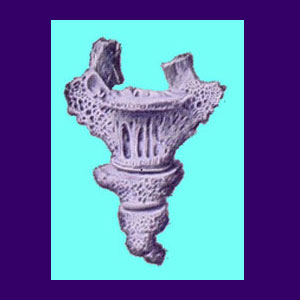
The coccyx, also called the tailbone, is the final region of the spine, located below the sacrum. This enigmatic structure is the evolutionary remains of what used to be a tail in human ancestors. The tailbone consists of 3 to 5 fused vertebrae with 4 being average. These vertebrae do not have individual names. The vertebrae may be fused as one solid piece of bone or may exist in segments of 2 or more bones each.
Being that natural fault lines exist in even solidly joined coccygeal segments, these marks can make the diagnosis of suspected fractures a difficult and imprecise task. Some fractures are never found while others are misdiagnosed as being present when the imaging study is only showing a natural vertebral demarcation. The tailbone is joined to the sacrum by the vestigial disc and ligaments. These soft tissue components allow a certain degree of movement of the coccygeal structure.
This essay focuses on explaining the human tailbone and demonstrating how it can be affected by many painful syndromes.
Coccyx Anatomy
The tailbone has only a limited ability to move independently of the sacrum. The exception to this general rule occurs when a woman is pregnant. In this case, the coccyx is able to move quite freely to allow an easier passage for childbirth. In most women, the tailbone is rotated and faces backwards. This makes it prominent and easily damaged, especially from a fall or during childbirth.
In general, the tailbone can be injured in any fall that lands the person on the base of their spine. Sporting injuries are also common reasons for a person to suffer coccygeal symptoms. In most instances of a fractured tailbone, the bones will heal naturally and without active medical treatment. In instances of a compound fracture, closed reduction or even invasive surgery might be required to resolve the injury completely.
After any coccygeal trauma, it is crucial to keep the area rested and not stressed by sitting too much or applying reclined pressure, such as lying on the back.
Tailbone Pain
Coccygeal pain syndromes are known as some of the most stubborn and therapy-defiant of all dorsalgia conditions. While there may be some reasons for purely structural pain emanating from the tailbone, not all these chronic cases are anatomically-enacted. In cases of known traumatic injury or fracture, injury may be present and may take a very long time to fully resolve. However, with time and care, most of these pain syndromes should end within a few weeks to a few months time.
Ongoing pain conditions which endure longer might indicate a nonstructural source process, such as ischemia, as being responsible for the suffering.
Noted physician, Dr. John Sarno, writes that many cases of his TMS diagnosis are located primarily in the coccygeal anatomy.
For more information on tailbone symptoms, please see our coccyx pain resource section.




